Origins of SPECTRE
11th October 2014
Guest writer Twan Arts inspects SPECTRE's uneasy birth and transition from screenplay to novel and back to screen
 By MI6 Staff
By MI6 Staff
"I am a member of SPECTRE. Special Executive for Counter Intelligence, Terrorism, Revenge, Extortion. The four great cornerstones of power headed by the greatest brains in the world."
This is how in, 1962, cinema audiences were introduced to the most notorious enemy of James Bond and MI6. The words were spoken by Dr. No, an embittered German-Chinese scientist who, after being ignored by both Western and Eastern governments, decided to sell his knowledge to the highest bidder. But who or what exactly is SPECTRE? Where lie their origins? And what are the main differences between the Fleming novels and the EON films?
A CREATIVE PROCESS: It was during a series of brainstorm sessions between writers Ian Fleming, Jack Whittingham and producer Kevin McClory that the now-infamous criminal organisation was conceived. Several James Bond novels had already been published and Fleming was desperately seeking for a way to bring his secret agent to the big screen. In his quest he stumbled upon McClory, a film producer with a vivid imagination. Together with Whittingham they started drafting a big screen 007 film script. Who in this creative process actually came up with what, is an unresolved question that has been the topic of numerous lawsuits in the past decades. But what is certain is that the attempt to get this script into a final draft and ready for shooting was never successful. Fleming, liking the rough material they came up with, decided to use it for his next Bond thriller "Thunderball" (1961), so beginning more than fifty years of unresolved issues and more than a little controversy.
THE EARLY DAYS: In the novel "Thunderball" we learn that the founder of SPECTRE was a man called Ernst Stavro Blofeld. He was born in 1908 as a son of a Polish father and a Greek mother. In 1938, with the world on the brink of war, Blofeld was working at the Polish Ministry of Posts & Telegraphs. Foreseeing the coming of World War II, the would-be villain made the shrewd decision to sell top-secret information to Nazi Germany and used the revenues to set up his own private intelligence organisation. During the war, Blofeld made a fortune by selling vital information to both the Axis and Allied powers. When he saw that the Nazis were losing the war, he solemnly helped the Allied forces and was awarded with several medals. In the years after WWII Blofeld reformed his intelligence organisation into the commercial enterprise known as SPECTRE.
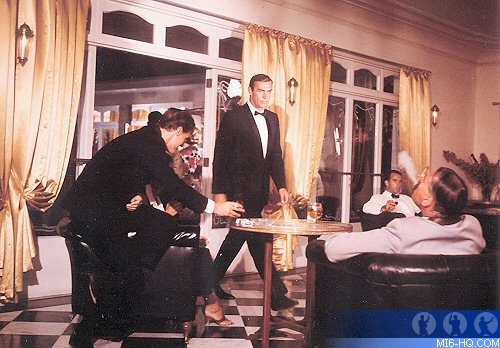
Above: Sean Connery in "Thunderball", with Kevin McClory (right, facing the camera) making a cameo.
THE STRUCTURE OF SPECTRE: As its founder, Blofeld surrounded himself with men who were already active within criminal organisations, recruiting from institutions such as the Gestapo, the US mob and SMERSH. Their headquarters was located in Paris, on Boulevard Haussmann with a charity organization for refugees called Firco as a front. (In the film it is called International Brotherhood for the Assistance of Stateless Persons). SPECTRE's 21 board-members from all over Europe did not know their counterparts' true identities and the whole institution was shrouded in secrecy. Anonymity was their first line of defence, and it became common practice to refer to each other member only by a call number. In the novel these numbers were randomly assigned and changed every month to prevent detection. Blofeld, it is revealed in the novel, was known to the others as Number Two and served as the chairman. Should anything happen to Number he would be replaced by Number One, the Italian Emilio Largo. The call-signs of SPECTRE's operatives in the film series are not rotating and Blofeld would always be known as Number One.
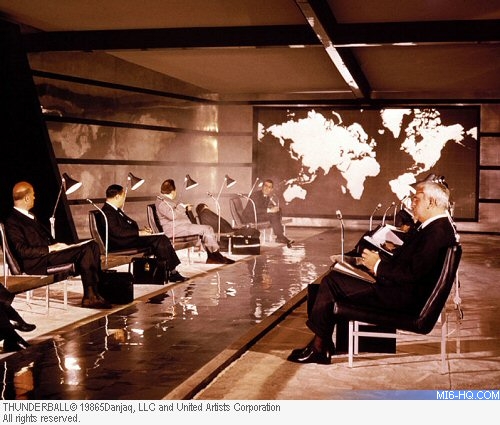
Above: A meeting of SPECTRE at their Parisian headquarters depicted in 1965's "Thunderball".
The first time post-War Western intelligence agencies learn of SPECTRE is when they hijack two nuclear weapons and hold the world ransom. This operation, codename Omega, was supposed to be their biggest undertaking since their inception. But, thanks to 007, their plan to blackmail NATO fails and the bombs are recovered. Several SPECTRE members are put out of action in the course of the Thunderball mission. A handful, including Largo are killed in the course of 007's mission and the CIA captures Number Five, an East German physicist known as Kotze. Thanks to his confession SPECTRE is largely dismembered; Blofeld manages to escape arrest.
Besides a brief mention in the next novel, "The Spy Who Loved Me", SPECTRE and Blofeld return in "On Her Majesty's Secret Service". But, the organisation is clearly less influential and Blofeld has something of personal vendetta against the British. They do not operate on their own but a hired by an unnamed country to cause havoc in the West. Operating from a former ski club in the Swiss Alps it is once again 007 who foils their destructive plans. Blofeld and his assistant, Irma Bunt, escape to return in the next novel, "You Only Live Twice". Here it seems that SPECTRE has not survived its two consecutive defeats and Blofeld alone, operating without an organisational front or a great deal of funds to back him up. With the death of its leader by the end of the novel, this also signals the end of SPECTRE in the Ian Fleming Bond novels.
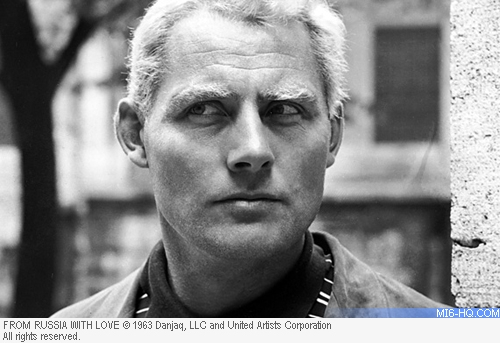
Above: SPECTRE's muscle, Donald 'Red' Grant played by Robert Shaw.
AT THE MOVIES: In the Bond film series SPECTRE plays a much larger role. Right from the start, the criminal organisation is introduced. In the novel Dr. No works for the Russians, but in a tactful move the filmmakers reattributed the villainy to secret organisation SPECTRE. Whilst SPECTRE was only briefly introduced here, the next film, "From Russia With Love", would give them a much larger role and offer viewers insight into the their structure and firepower. Again, the "From Russia" novel pits 007 against Russian villains Rosa Klebb and Kronsteen, working for SMERSH to discredit the British Cold War espionage efforts. In the film they are agents of SPECTRE, Number Three and Number Five, respectively. It also features the first on-screen appearance of Blofeld (played in the flesh by Anthony Dawson, who ‘died' in the last outing as Professor Dent). With their own private island and small army SPECTRE is clearly a better funded and more threatening agency than they are in the Fleming novels. Their logo, a black Octopus, is proudly worn as a ring by several key operatives. Their strategy is simple but ingenious: cause conflict between the East and the West and take advantage of this for their own good, acquiring military grade secrets and encryption codes.
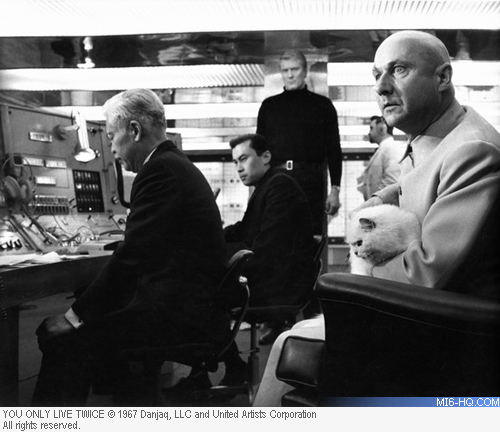
Above: Blofeld's face is revealed for the first time in "You Only Live Twice", played by Donald Pleasence. Jan Werich was originally hired to play Blofeld but thought not menacing enough. Re-casting and re-shooting took place midway through production.
The appearance of SPECTRE in the film "Thunderball" largely follows the novel's premise. For the next film, "You Only Live Twice," this is not the case and the filmmakers depart rather dramatically from the plot of Fleming's revenge novel. Legal issues surrounding the ownership of the material pushed "Thunderball" to take the place of "On Her Majesty's Secret Service" as the fourth film by EON Productions. As it transpired, Bond had yet to encounter his bride-to-be, Tracy, making the fifth Bond adventure, "You Only Live Twice" senseless as a revenge mission without the death of his bride to avenge.
Thus, in the film, SPECTRE is hired by an unnamed Asian country to create a war between the West and the USSR. Their base, lavishly financed by this country, is located in Japan within a hollowed out volcano.
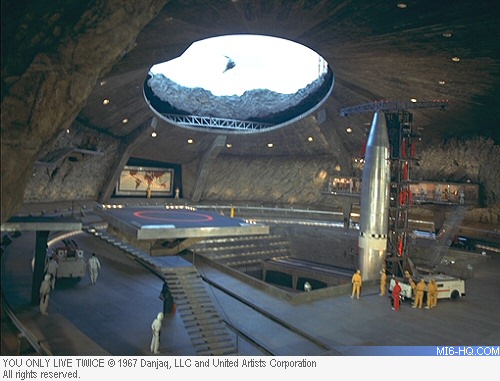
Above: The hollowed-out volcano that alluded the Japanese Secret Service in their search for the saboteur's rocket location.
SPECTRE's next screen appearance in "On Her Majesty's Secret Service" also follows the novel. The key difference is that, in the novel, Blofeld is reliant on a third party financier, whereas the film gives no hint of this. Blofeld appears to be driven by ego: the right to call himself Count taking precedence over the terror he causes to the established international powers. Both the book and the film end with the murder of James Bond's wife Tracy on the day they get married.
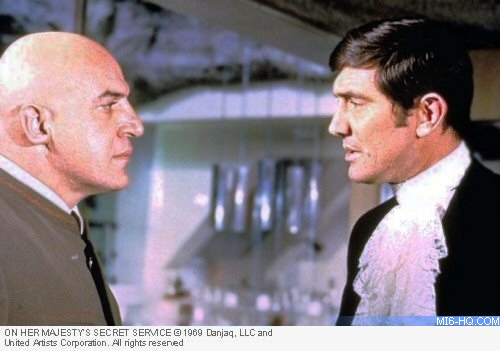
Above: Telly Savalas as Blofeld in "On Her Majesty's Secret Service" (1969) confronting 007 who poses as Sir Hillary Bray.
It is because of this horror that 007 starts his next film, "Diamonds Are Forever", on a quest for revenge; Bond eventually finds that it is Blofeld in his newest guise behind the diamond smuggling he is investigating for 'M'. The novel did not featured SPECTRE or it's leader. This would be the last appearance of SPECTRE in the official 007 series, although a Blofeld-lookalike makes a cameo return in the opening of "For Your Eyes Only". The bald-headed-cat-hugger is dropped from a height into the smokestacks of a disbanded factory. For legal reasons Kevin McClory retained the copyright to 007's nemesis and was able to use the character and his organisation in his "Thunderball" remake, the 1983 film "Never Say Never Again."






